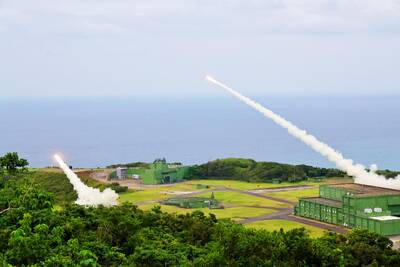Traditional Chinese puppeteers in Taiwan should face the future by emphasizing the tradition’s origins as a fine performative art and attracting adult audiences with sophisticated tastes, Unique Puppet Theater’s 26-year-old troupe master Kuo Chien-fu (郭建甫) said.
Kuo is not only a student at China University of Technology’s Graduate Institute of Visual Communication and Design in Taipei, but is also a traditional hand-puppet performer and puppet maker who has led the Unique Puppet Theater since he founded the troupe in 2012.
The artist’s puppets were highlighted by President Tsai Ing-wen (蔡英文) last year, when she gave several as an official gift to the presidents of Panama and Paraguay during her diplomatic visits in Central America.

Photo: Wu Po-hsuan, Taipei Times
Kuo said he used to watch traditional Chinese operas with his great-grandfather as a child and fell in love with the visual elements of the performances, which he later delved into when he explored traditional puppetry at his elementary school’s students’ association.
By junior-high school, he was learning the craft with a professional puppetry troupe, and by senior-high school, he was confident enough to introduce himself to the renowned puppeteer Chen Xi-huang (陳錫煌) after Chen performed at the Tataocheng Opera Court (大稻埕戲苑), Kuo said.
At the time of his apprenticeship, his interest in traditional puppet theater was limited to creating puppets, rather than performance, Kuo said.
However, Chen insisted that puppetry is a holistic art that encompasses all skills involved in puppetry, including painting and engraving puppets, embroidering their costumes, performing music, stage acting, poetry and puppet manipulation, Kuo said.
“I really did not want to learn puppet manipulation because it was difficult, but Chen said you must learn how to manipulate a puppet to learn how to make practical and useful puppets,” he said, adding that Chen’s tutelage had taught him to become a well-rounded performer.
Puppet manipulation was a challenging art and making a puppet kick is a skill that took him six months to master, Kuo said.
In 2012, he received Chen’s formal recognition as an apprentice, a prestigious position that made him the third-generation successor of hand puppetry master Li Tien-lu (李天祿).
“When you have a master, you are entrusted with a heritage and become responsible for your actions,” he said, adding that he started the Unique Puppet Theater in the same year to expand and pass on what he had learned.
Kuo divides his time between practicing with the troupe during the day and taking classes on visual communication theory at the university in the evening, while also working as the Gu Gallery’s (源古本舖) resident performer and participating in the Ministry of Culture’s program to preserve traditional arts, he said.
He acknowledged media reports that components for the heads of the puppet he made for Tsai were purchased from China, but added that they were received as “raw materials” that needed in-house assembly, costumes and embroidery to become complete and functional puppets.
The cost of producing puppets is rising in China and the troupe is considering sourcing from manufacturers in Southeast Asia, with Taiwanese artists maintaining critical skills and design, Kuo added.
The Unique Puppet Theater performs internationally, and has staged performances in Japan, the US, Singapore, the Netherlands, Hong Kong, Turkey, Malaysia and France in the past three years, Kuo said, describing the tours as “an unfortunate necessity caused by the shrinking market for classical puppetry.”
“Classical puppetry cannot compete with television or movie theaters as mass culture. Its future lies in its sophisticated aesthetics of movement, figures, costumes and artistic presentation,” he said.
“Performing abroad is a way for us to expand our perspectives, but it is unfortunate that by comparison, foreigners have more respect for puppetry as a traditional heritage, while domestically, people see it as something for children,” he added.
The Unique Puppet Theater aims to avoid reliance on proceeds from ticket sales or public subsidies, Kuo said, adding that traditional puppetry is a fine art that thrives best within a niche of adult aficionados, which the troupe cultivates by holding seminars.
Taiwan’s heritage of traditional puppetry is in decline and most of the nation’s 300 performance troupes have disbanded, he said, making conservation an urgent task.
Currently, he is interviewing elders in the profession to record their knowledge, as well as the culture and context of puppet plays for inclusion in a book that he intends to publish, Kuo said.
The government should help preserve traditional puppetry by encouraging educational institutions to offer classes and programs to groom professionals, he added.

Trips for more than 100,000 international and domestic air travelers could be disrupted as China launches a military exercise around Taiwan today, Taiwan’s Civil Aviation Administration (CAA) said yesterday. The exercise could affect nearly 900 flights scheduled to enter the Taipei Flight Information Region (FIR) during the exercise window, it added. A notice issued by the Chinese Civil Aviation Administration showed there would be seven temporary zones around the Taiwan Strait which would be used for live-fire exercises, lasting from 8am to 6pm today. All aircraft are prohibited from entering during exercise, it says. Taipei FIR has 14 international air routes and

Taiwan lacks effective and cost-efficient armaments to intercept rockets, making the planned “T-Dome” interception system necessary, two experts said on Tuesday. The concerns were raised after China’s military fired two waves of rockets during live-fire drills around Taiwan on Tuesday, part of two-day exercises code-named “Justice Mission 2025.” The first wave involved 17 rockets launched at 9am from Pingtan in China’s Fujian Province, according to Lieutenant General Hsieh Jih-sheng (謝日升) of the Office of the Deputy Chief of the General Staff for Intelligence at the Ministry of National Defense. Those rockets landed 70 nautical miles (129.6km) northeast of Keelung without flying over Taiwan,

City buses in Taipei and New Taipei City, as well as the Taipei MRT, would on Saturday begin accepting QR code payments from five electronic payment providers, the Taipei Department of Transportation said yesterday. The new option would allow passengers to use the “transportation QR code” feature from EasyWallet, iPass Money, iCash Pay, Jkopay or PXPay Plus. Passengers should open their preferred electronic payment app, select the “transportation code” — not the regular payment code — unlock it, and scan the code at ticket readers or gates, General Planning Division Director-General Liu Kuo-chu (劉國著) said. People should move through the

The Ministry of National Defense (MND) today released images of the military tracking China’s People's Liberation Army (PLA) movements during the latest round of Chinese drills around Taiwan. The PLA began "Justice Mission 2025" drills today, carrying out live-fire drills, simulated strikes on land and maritime targets, and exercises to blockade the nation's main ports. The exercises are to continue tomorrow, with the PLA announcing sea and air space restrictions for five zones around Taiwan for 10 hours starting from 8:30am. The ministry today released images showing a Chinese J-16 fighter jet tracked by a F-16V Block 20 jet and the